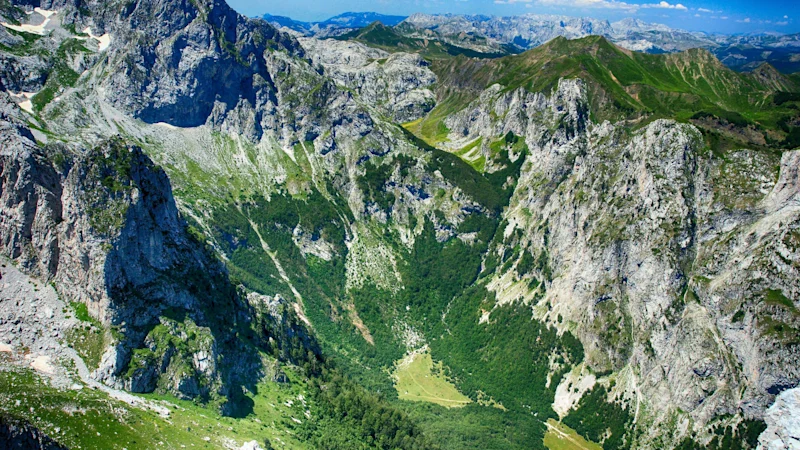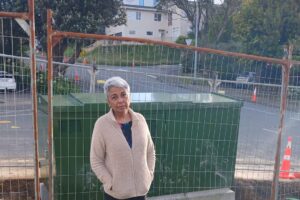
November 6, 2025 — 8:56am
Save
You have reached your maximum number of saved items.
Remove items from your saved list to add more.
Save this article for later
Add articles to your saved list and come back to them anytime.
Got it
There’s a moment, as our boat skims across the placid waters of Montenegro’s Lake Skadar on day seven of our Balkans hike, when the guide unexpectedly breaks out a box of fresh dough balls, a bottle of red wine and a bottle of rakia, the popular and ubiquitous local firewater.
The Accursed Mountains on the border between Montenegro, Albania and Kosovo.Alamy
As we toast the trip and each other, we realise that our nine-strong group met only a week ago. It feels, we agree, more like a month. In a good way.
That’s because every day has brought with it a cornucopia of things seen, done, eaten, drunk and gawped at. From the bracing turquoise waters of the Blue Eye spring above the hamlet of Nderlysaj, to the high mountain pass where, just after we cross it, someone plummets to their death, we have travelled through a little-visited world of remarkable landscapes and unfailingly generous hospitality.
We started day three of the trip on the outskirts of Gusinje in Montenegro, where we trek for eight hours across the border into Albania before the precipitous descent into the popular hiking village of Theth.
That evening, sitting in the Bujtina Polia guesthouse’s garden, drinking a much-needed cold beer before dinner, I read that early 20th-century adventurer Edith Durham had attempted to trek the other way around, from Theth to Gusinje, in 1908.
On the trail in Theth National Park, Albania.Alamy
In her book High Albania, published in 1909, she wrote: “It had not occurred to me before that it was possible to find a way over what looked like a wall at the end of all the world.”
On looking back that very afternoon, our guide had pointed to the faraway pass from where we had come, and it did, indeed, look like some great grey, impassable wall. Even at the time, without Durham’s description, I was glad the thing was behind and not ahead of us.
“We started,” wrote Durham, “up the steep, very steep trail that zigzagged over masses of loose rock and boulder that had crashed down the mountain from above. The higher we got the steeper was the track … about halfway up is a great cavern formed by a mass of overhanging strata, and blackened by the fires of the wayfarers who rest here.”
This was the very same cavern where we, too, had stopped to rest, to scoff snacks, drink water and, in my case, apply a few pre-emptive Band-Aids to cushion the descent and avoid nascent blisters. Edith Durham doesn’t much mention her own tribulations but, then, she was on horseback, the cheating minx.
Things have obviously changed since Durham’s day – some good, some bad. She would never, for instance, have encountered the concrete machine-gun pillbox that now sits, abandoned, at the top of the Theth valley, facing menacingly back towards Montenegro – one of 750,000 built across Albania during the mad, 40-year one-party communist reign of paranoid dictator Enver Hoxha.
What wouldn’t have changed, though, are the mountains, the valleys and the high passes through which that bold Victorian lady travelled. Burgeoning tourism to this much-neglected part of the world might have watered down Durham’s observation that “no place where human beings live has given me such an impression of majestic isolation from all the world. It is a spot where centuries shrivel” – but not by much.
Permission to baulk: Tackling the Balkans High Trails.
It is important, early on, to note that among the helpful information provided by travel company UTracks – visa requirements, equipment and clothing suggestions, etc – is that this grade 4 hike is deemed to be “moderate to challenging”.
It’s described as “guided daily walks of around three to eight hours with a maximum ascent and descent of 1200 metres … there are some stages of the walk where you will encounter steep uphills, descents and many sections of the trail which require care, including over rocky ground”.
Written baldly like that it doesn’t seem too burdensome but, trust me, this is not the case. There are times when we crest a rise only to be confronted by a yet another scree-covered switchback track up what looks like a sheer wall of rock that I wonder why I’m doing this to myself. My thighs concur.
But then we hit a summit, gaze in wonder at the rugged mountainous panorama and distant, wooded valley in front of us, and it all has been worth it.
The long road there.
Our guide is Semir Kardovic, 40, from Montenegro, who has been walking these mountainsides for 23 years, and the eight-strong group he is leading is made up of experienced hikers – Kilimanjaro, Mont Blanc, the Inca Trail, Bhutan – from the US, Ireland and the UK, aged from 47-67.
Seven days ago, Semir picked us up in the Kosovo capital, Pristina, and we drove straight to Peja, on the eastern edge of the Accursed Mountains, also known as the Albanian Alps, for lunch, a short city tour and a fleeting visit to the beautiful Orthodox Visoki Decani monastery, a UNESCO World Heritage site.
Lunch sets the culinary tone for the rest of the tour. We are led to a vine-covered courtyard at Kulla E Zenel Beut, a popular local restaurant serving traditional Balkan cuisine. This means plenty of meat, peppers, salad, bread, and cheese, cheese and more cheese. I try a Skanderberg sausage (named after a great Albanian hero of yore), which turns out to be a roll of meat stuffed with cheese, breaded, fried and covered with creamy white dressing.
In general (with the exception of a stunning locavore lunch at Mrizi i Zanave agri-tourism restaurant at Fishte in Albania), the food on the tour is nothing fancy, just simple fare, simply cooked and piled high. You might be walking seven or more hours a day, but you’ll be hard-pressed to lose any weight, that’s for sure.
Conquering the Alps.
It’s the same with the accommodation, which is clean, unassuming and perfectly fit for purpose (which is, essentially, a shower and a bed to collapse into after dinner). Though the hotel on our last night, in Kotor, is a charming three-star boutique hotel right in the middle of the medieval old town.
The hiking, which begins from the front of our hotel at 9am on the second day, is often hard going but never short of spectacular. Thigh-wincingly steep climbs up barren grey rock on slippery scree open up to vast, dazzling vistas that give anything you might find in the more manicured Alps or the Dolomites a run for their money, and with fewer people.
Related Article
The topography changes constantly, too. One moment we walk through charmingly bosky forests of pine, fir and spruce, only to pop out into wide, flat valleys surrounded by jagged karst mountain crags – what Durham called “aching wildernesses, the bare bones of a half-created world”. “Challenging” it most certainly is but, if you’ve got the legs and lungs for it, it’s worth it.
Included in the tour is a relaxing two-hour ferry ride on Lake Koman, several city tours and a visit to the old castle that sits on a hill with 360-degree views of the countryside around Shkodra.
Our final day begins in the fishing village of Virpazar with that boat ride on Lake Skadar and ends with a heady three-hour descent that offers magnificent bird’s-eye views of the sheltered Bay of Kotor.
At the bottom, as we walk exhausted beneath the gates into Kotor old town, a sentence towards the end of Durham’s High Albania comes to mind: “By noon, the wonder-world of the mountains was left behind us.”
Wonder-world? Yeah, that’s about right.
The details
Fly
There are no direct flights from Australia to Pristina, Kosovo’s capital, where the tour starts. Plenty of local European airlines have flights from places such as Istanbul, Geneva, Zurich, Berlin, London and Frankfurt.
Tour
UTracks is a specialist in active travel that lets you become completely immersed in your trip and promotes experiences with local people, cultures and communities. The eight-day Balkans High Trails and Culture Guided Hike (maximum six-14 people) includes seven breakfasts, six lunches, seven dinners and seven nights’ accommodation in local hotels and guesthouses. From $3350 a person, twin share. Includes luggage transfers, an English-speaking guide and entrance fees for sights and national parks. Departure dates for 2026 are May 29, July 3, August 14, and September 11.
Sign up for the Traveller Deals newsletter
Get exclusive travel deals delivered straight to your inbox. Sign up now.
Save
You have reached your maximum number of saved items.
Remove items from your saved list to add more.
Originally from London’s East End, Keith Austin has worked as a journalist in the UK, China and Australia. He is a former Sydney Morning Herald travel editor, and the author of three Young Adult novels.





